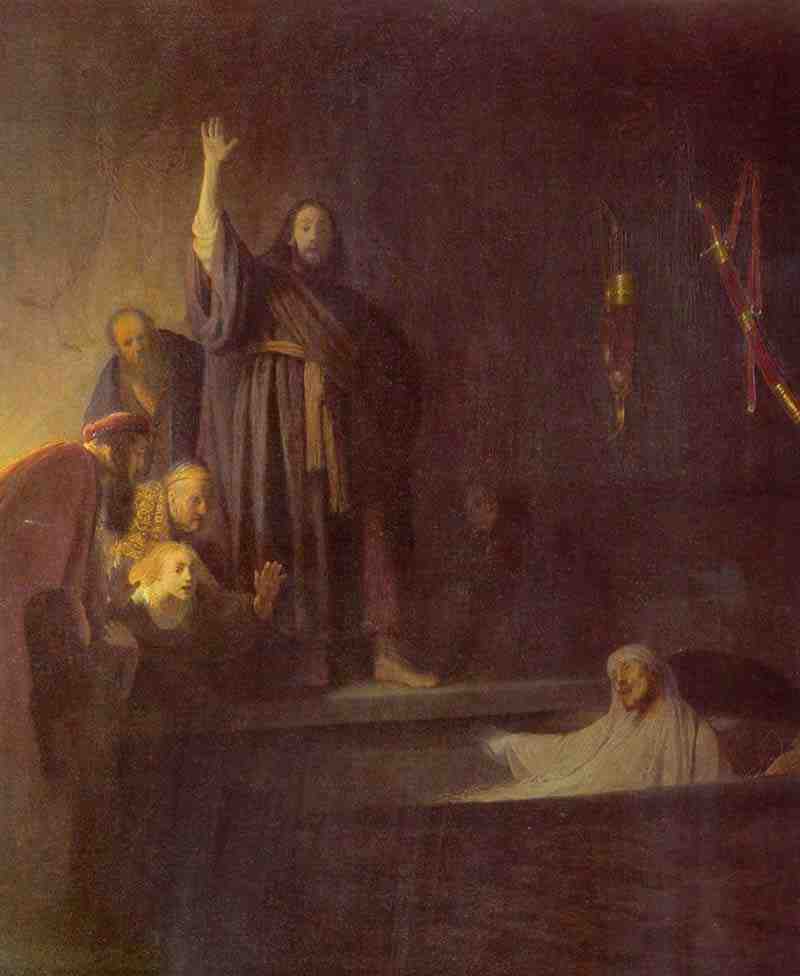
The Raising of Lazarus. Rembrandt Harmensz. van Rijn
---
Auferweckung des Lazarus. Rembrandt Harmensz. van Rijn
um 1630, Öl auf Holz, 96,2 × 81,5 cm
Los Angeles, Country Museum of Art
----
Η Ανάσταση του Λαζάρου. Ρέμπραντ Χάρμενσζον φαν Ράιν
περίπου 1630, λάδι σε πάνελ, 96,2 × 81,5 εκ
Λος Άντζελες, Εθνικό Μουσείο Τέχνης
----
Fine Art Prints | Greeting Cards | Phone Cases | Lifestyle | Face Masks | Men's , Women' Apparel | Home Decor | jigsaw puzzles | Notebooks | Tapestries | ...
----
The Raising of Lazarus is an oil on panel painting by the Dutch artist Rembrandt. The work depicts the Raising of Lazarus as told in the Gospel of John, Chapter 10 verses 38 through 44. It is now in the Los Angeles County Museum of Art.
Imagery
The painting shows the moment Lazarus re-awakens from death and raises out of his tomb as Christ calls him. Lazarus (and another corpse in the background) exists in a darker half of the painting while the other living figures are far more illuminated. Mary and those assembled look on in amazement as Lazarus comes to life. Sister Wendy Beckett opines that Jesus is portrayed as a weary magician, rather than a triumphant savior. The painting depicts a parable of spiritual life, the miracle of the hardened sinner receiving first grace (sorrow for sins committed in order to seek penitence and redemption).[1] Rembrandt used chiaroscuro (contrasts of light and dark) in this painting, with the dark interior of the burial cave and the limited torchlight focusing the attention of the viewer and giving the figures impact. This is one of relatively few religious subjects from the New Testament that Rembrandt painted, though large numbers of his prints have religious subjects.
History
The Raising of Lazarus was painted early in Rembrandt’s career, while he was still in Leiden not long after his apprenticeship under Pieter Lastman, whose influence is still clear. Rembrandt made two etchings of the same name, one in approximately 1632 and another in 1642. Both show the same scene from the Gospel of John but different compositions: the 1632 etching shows a different point of view while the 1642 etching shows different figures in the cave. The 1642 painting also depicts Christ as more of a healer, than the enchanter of this work. The subject of this painting may draw on an undated Jan Lievens etching of the same name. Lievens and Rembrandt were friends and probably worked together.[2] The composition of the painting may derive from a drawing by Rembrandt from the same time of the Burial of Christ. Rembrandt would most closely imitate Raising of Lazarus with his 1635/1639 painting The Resurrection. The placement of the figures is similar and study of drawings indicate the latter was developed from the former.
Provenance
Raising of Lazarus was owned by Rembrandt for most of his life; it was sold in his bankruptcy sale in 1656.[3] It was inventoried as being hung in Rembrandt’s anteroom. The painting passed through various owners in Europe until it was bought by Howard F. Ahmanson, Sr. in 1959 and then donated to the LA County Museum of Art.
References
^ Sister Wendy’s American Collection: LACMA, VHS. (2000; Boston, MA: WGBH/ Spire Films, 2003)
^ Wolfgang Stechow, “Rembrandt's representations of the Raising of Lazarus,” Bulletin of the Los Angeles County Museum of Art 19, no. 2 (1973)
^ Ben B. Johnson, “Examination and treatment of Rembrandt's Raising of Lazarus,” Bulletin of the Los Angeles County Museum of Art 20, no. 2 (1974):
Retrieved from "http://en.wikipedia.org/"
All text is available under the terms of the GNU Free Documentation License


